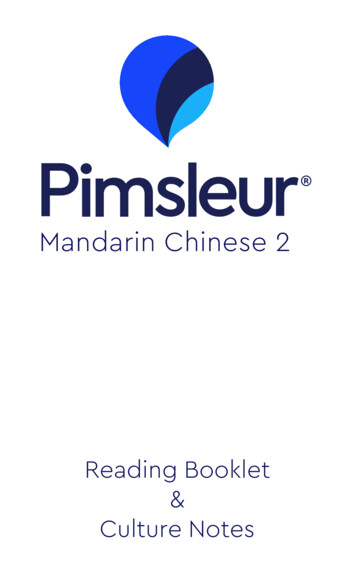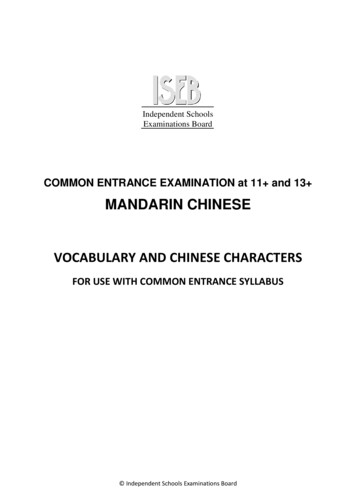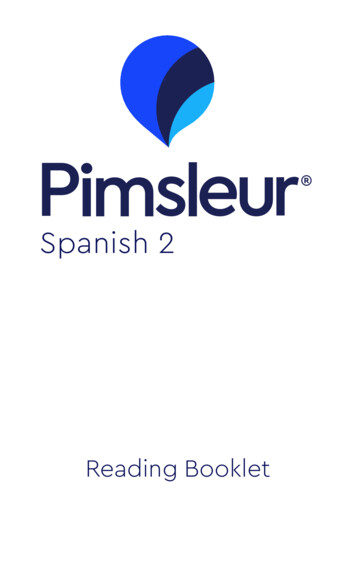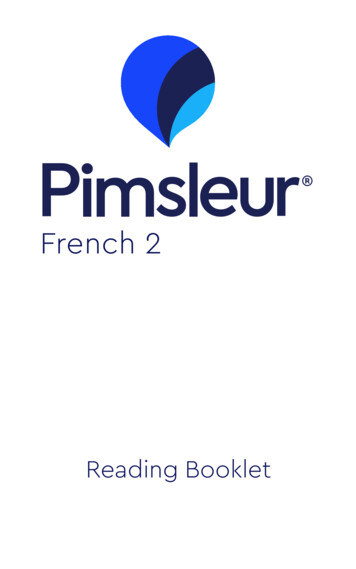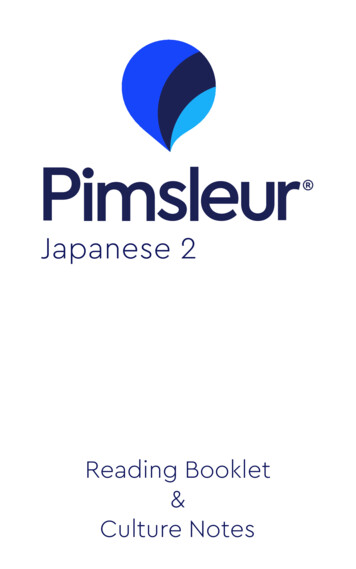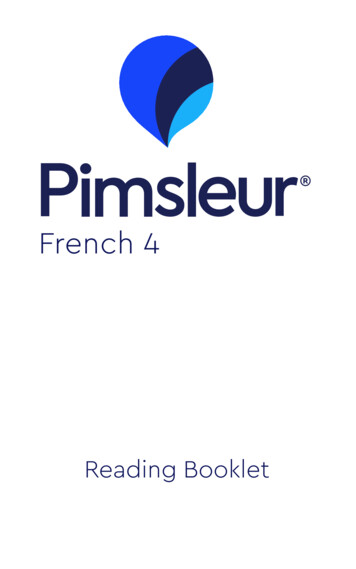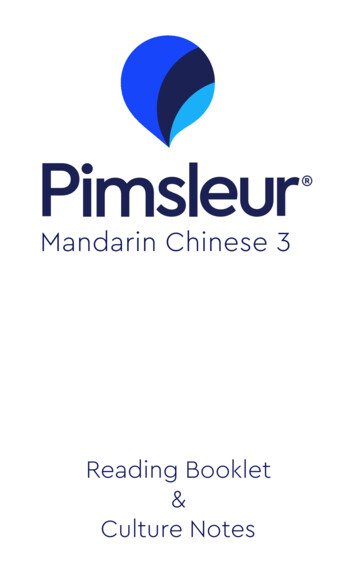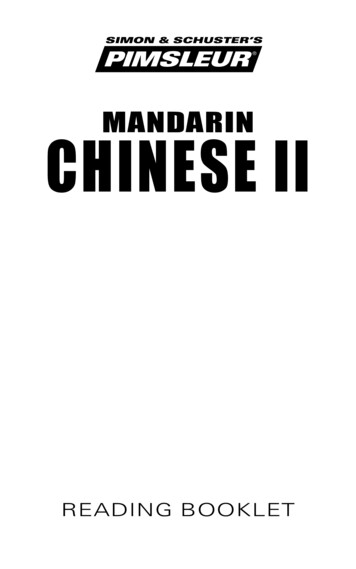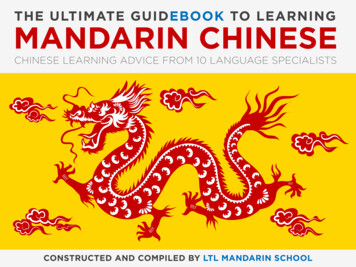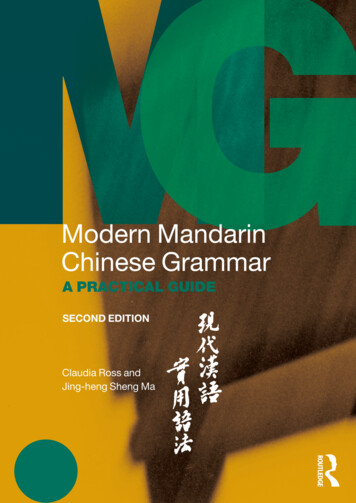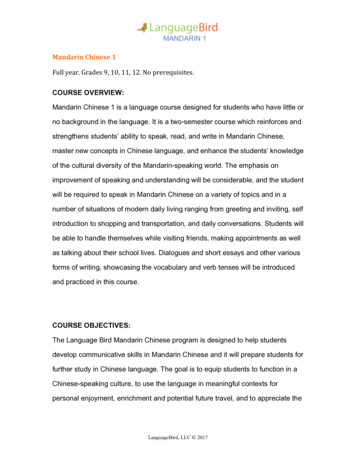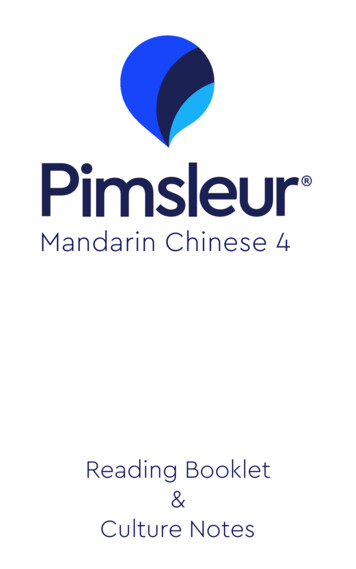
Transcription
Mandarin Chinese 4Reading Booklet&Culture Notes
Mandarin Chinese 4Travelers should always check withtheir nation’s State Department forcurrent advisories on local conditionsbefore traveling abroad.Booklet Design: Maia Kennedy and ‰ Recorded Program 2013 Simon & Schuster, Inc. Reading Booklet 2016 Simon & Schuster, Inc.Pimsleur is an imprint of Simon & Schuster Audio,a division of Simon & Schuster, Inc. Mfg. in USA.All rights reserved.ii
Mandarin Chinese 4ACKNOWLEDGMENTSVoicesAudio ProgramEnglish-Speaking Instructor . . . . . . . . . . Ray BrownMandarin-Speaking Instructor . . . . . Zongyao YangFemale Mandarin Speaker . . . . . . . . . Xinxing YangMale Mandarin Speaker . . . . . . . Pengcheng WangReading LessonsMale Mandarin Speaker . . . . . . . . . . . . . . Jay JiangAudio Program Course WritersYaohua Shi Christopher J. GaintyEditorsShannon D. Rossi Beverly D. HeinleReading Lesson WritersXinxing Yang Elizabeth HorberReviewerZhijie JiaProducer & DirectorSarah H. McInnisRecording EngineerPeter S. TurpinSimon & Schuster Studios, Concord, MAiiiiii
Mandarin Chinese 4Table of ContentsIntroductionMandarin. 1Pictographs. 2Traditional and Simplified Script. 3Pinyin Transliteration. 3Readings . 4Tonality. 5Tone Change or Tone Sandhi. 8Pinyin Pronunciation Chart. 10Lesson One. 14Translations. 15Lesson Two . 16Translations. 17Lesson Three. 18Translations . 19Lesson Four. 20Translations . 21Lesson Five. 22Translations. 23Lesson Six. 24Translations . 25Lesson Seven. 26Translations . 27Lesson Eight. 28Translations . 29iviv
Mandarin Chinese 4Lesson Nine. 30Translations. 31Lesson Ten. 32Translations. 33Lesson Eleven . 34Translations. 35Lesson Twelve . 36Translations . 37Lesson Thirteen. 38Translations . 39Lesson Fourteen. 40Translations . 41Lesson Fifteen. 43Translations . 44Lesson Sixteen . 45Translations. 46Lesson Seventeen . 47Translations . 48Lesson Eighteen . 49Translations . 50Lesson Nineteen . 52Translations . 53Lesson Twenty . 55Translations. 56v
Mandarin Chinese 4To learn a language is to have one more windowfrom which to look at the world.Chinese proverbvi
Mandarin Chinese 4MandarinMandarin Chinese, also known as StandardChinese or Modern Standard Mandarin, is the soleofficial language of China and Taiwan, and one of thefour official languages of Singapore. Although thereare eight major Chinese dialects, Mandarin is native toapproximately 70% of the population. Chinese whoare educated through at least the primary gradesspeak Mandarin as well as the local dialects. However,due to the size of China and the ethnic diversity of itsinhabitants, hundreds of other dialects are spoken indifferent areas. The dialects spoken today are basedmore on geography than on ethnicity. For instance,residents of Shanghai will speak Wu, and in some partsof China, particularly the central and southern areas,official business is transacted in the locally dominantlanguage. Although people from different parts ofChina generally do not understand one another’sspoken language, they all use Mandarin characters(hanzi) for writing.Today’s Mandarin is closely based on “northernspeech” which was the lingua franca of the rulingclass, spoken in Beijing, the capital during the Mingand Qing Dynasties. After the Nationalists overthrewthe Qing Dynasty in 1912, government officials atfirst considered creating a new “national language”by adopting a mixture of dialects, but in the end itwas decided to retain Mandarin as the “NationalLanguage.” The Communists, who defeated the
Mandarin Chinese 4Nationalists in 1949, continued this policy, but theychanged the name and coined the term pu tonghua, or “common speech,” for “Mandarin.” This isthe word for Mandarin used throughout mainlandChina. In Hong Kong, however, as in Taiwan andmost overseas communities, guo yu, the older term,continues to be used.Pronunciation of the national language differsslightly geographically, and there are some significantregional vocabulary differences. The Nationalists,whose capital was the southern city of Nanjing, wereinfluenced by southern dialects, primarily Cantonese.The Communists, whose capital is Beijing, wereinfluenced by “northern speech.”PictographsIt is commonly thought that every Chinesecharacter is a picture, or “pictograph,” but only afew hundred of the several thousand characters aretrue pictographs. However, most of these are nowwritten in such a way that it is difficult to immediatelyguess their meaning. There is also a very small groupof characters called ideographs or ideograms, whichrepresent ideas or objects directly. All other Chinesecharacters are combinations of these pictographsand basic ideographs.2
Mandarin Chinese 4Traditional and Simplified ScriptIn 1949 China’s new government consideredinstituting an alphabet in place of the traditionalcharacters, as a refutation of traditional or “feudal”culture.Instead, they decided to simplify theexisting characters by reducing the number ofstrokes necessary to create them. By 1964, a list of2,200 simplified characters was created for use asa modified script. Further simplification was brieflyadopted, then abandoned, at the end of the CulturalRevolution in 1977.Presently, simplified characters are used inmainland China and Singapore, although there is amovement for the restoration of traditional characters,especially in southern China. Hong Kong, Taiwan, andmany overseas Chinese communities continue to usethe traditional characters.Pinyin TransliterationIn Level 4 you will continue practicing readingpinyin. It’s the official phonetic system for transcribing pronunciations of the Chinese charactersinto a Latin alphabet, and will give you a way to“read” an approximation of the sounds in writtenform. In China it’s often used in elementary schoolsas a first step toward learning to read. It is alsoused to alphabetically order dictionary entries, and3
Mandarin Chinese 4it is used for entering Chinese text into computersas well as communicating via email and text messaging. In many large cities, street signs are oftendisplayed in both Chinese characters and pinyin toaid foreign visitors.ReadingsThere are twenty Reading Lessons in all.Although the pinyin alphabet may appear similarto the Latin alphabet, the sounds of some lettersin pinyin are quite different. You will learn tosound out the pinyin starting with individualletters, then letter combinations, words, then wordcombinations and short phrases, building in lengthuntil you will be sounding out complete sentences.Keep in mind that learning to read pinyin is not thesame as learning to read the hanzi. These lessonsare designed to give you an easy way to “read”the Chinese sounds, and the Simplified Chinesecharacters are displayed as well.Feel free to repeat each Reading Lesson untilyou feel comfortable proceeding to the next. Witha little effort, you will be astonished at how quicklyyou are able to sound out the Mandarin words. Apronunciation chart is included which is for reference4
Mandarin Chinese 4only, however, as all the information you need to dothe readings is contained in the audio.Although translations are included, the meaningsat this point are secondary, and we recommendthat you look at them only after first attempting tosound out the phrases with Mandarin pronunciation.Each item has been selected especially to give youpractice in the tones, the sounds, and the soundcombinations. You should read aloud, as directed,which will help to lodge the sounds in your memory.Before long you will be reading pinyin aloud withoutan American accent.TonalityChinese is a tonal language. This means thatin addition to the sounds of the consonants andvowels, the tone with which a syllable is pronouncedhelps to determine its meaning. The Chineselanguages are almost exclusively made up of onesyllable words, composed of an initial consonantsound followed by the syllable’s main vowel,sometimes in combination with another consonantor vowel. Longer words do exist, but almost allare compound words, formed by combining onesyllable words.5
Mandarin Chinese 4The tone is determined by the pronunciation ofthe syllable’s main vowel. Each tone has a namewhich describes the motion of the sound: falling,rising, or even. With the tones, several meaningscan be assigned to any one syllable. For example,when pronounced using a falling-rising tone, theword nar means “where.” However, when pronounced with just a falling tone, it means “there.”There are four main tones used in speakingMandarin - high, rising, falling-rising, falling - anda fifth, referred to as a soft or neutral tone. Thislast tone is used for the second syllable in a setof doubled characters, as well as for the final syllable (or question word) at the end of a query. Thisneutral tone doesn't have a marker. For example,in the questions, ni ne? (How about you?) and haoma? (OK?), the syllables ne and ma are pronouncedusing this soft, falling sound, as if the sound is fadingaway. Here is an example of one word with different meanings depending on the tone with which itis pronounced: 1st tone: highshī (poem) 2nd tone: risingshí (ten or time) 3rd tone: falling-risingshĭ (history) 4th tone: fallingshì (to be)6
Mandarin Chinese 4There are tonal markers to indicate the tones ofthe vowels. In these lessons, we will include themfor the four tones above the vowels they affect. Payclose attention to t he markers because they canchange the meaning of a word completely. It maytake a while before you hear the differences, andwe encourage you to repeat each lesson as often asnecessary, in order to both familiarize yourself withthe Mandarin sounds represented by the letters andto practice the tones.All tonal markers are placed above the singlevowels (a, o, e, i, u, ü). The chart that follows usesthe vowel “a” as an example.Tone #English Name1.High-level tone - Starts withnormal vocal range of thespeaker and stays even.Rising tone - Starts atnormal vocal range, thenrises up.Falling-rising tone - Startsat normal vocal range, thenfalls down and rises up.Falling tone - Starts atnormal vocal range, thenfalls down.2.3.4.7Markershown with “a”āáăà
Mandarin Chinese 4In Mandarin the absence of a tonal marker above avowel, as in "a," indicates a neutral tone. This neutraltone starts with a slightly soft sound and is shorterthan the sounds of the tones listed above.Tone Change or Tone SandhiAlthough each Chinese syllable standing alonehas a specific tone, in the flow of speech the toneof a syllable can change depending on the tone ofthe following syllable. In some Chinese dialects, tonechange is common, and there are complex rulesgoverning it. In contemporary Mandarin, however, itis less common than in other dialects, and there areonly a few rules to remember. The first governs fallingrising or 3rd tones when they are spoken in sequence:1. When two falling-rising or 3rd tones occurtogether, the first falling-rising tone becomesa rising, or 2nd tone. The second remains afalling-rising or 3rd tone. For example, “very”and “good” are both falling-rising, 3rd tonesby themselves, but when spoken together ashen hao, the first word changes to a rising or2nd tone, while the second keeps its ori
are eight major Chinese dialects, Mandarin is native to approximately 70% of the population. Chinese who are educated through at least the primary grades speak Mandarin as well as the local dialects. However, due to the size of China and the ethnic diversity of its inhabitants, hundreds of other dialects are spoken in different areas. The dialects spoken today are based
